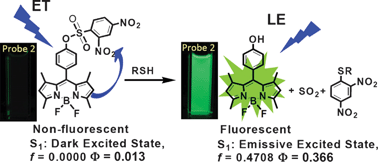Highly selective fluorescent OFF–ON thiolprobes based on dyads of BODIPY and potent intramolecular electron sink 2,4-dinitrobenzenesulfonyl subunits†
Abstract
Two highly selective OFF–ON green emitting fluorescent

* Corresponding authors
a
State Key Laboratory of Fine Chemicals, School of Chemical Engineering, Dalian University of Technology, Dalian 116024, P. R. China
E-mail:
zhaojzh@dlut.edu.cn, guohm@dlut.edu.cn
b Center Laboratory, Affiliated Zhongshan Hospital of Dalian University, Dalian 116001, P. R. China
c Department of Immunology, Harbin Medical University, 194 Xuefu Road, Harbin 150081, P. R. China
Two highly selective OFF–ON green emitting fluorescent

 Please wait while we load your content...
Something went wrong. Try again?
Please wait while we load your content...
Something went wrong. Try again?
H. Guo, Y. Jing, X. Yuan, S. Ji, J. Zhao, X. Li and Y. Kan, Org. Biomol. Chem., 2011, 9, 3844 DOI: 10.1039/C0OB00910E
To request permission to reproduce material from this article, please go to the Copyright Clearance Center request page.
If you are an author contributing to an RSC publication, you do not need to request permission provided correct acknowledgement is given.
If you are the author of this article, you do not need to request permission to reproduce figures and diagrams provided correct acknowledgement is given. If you want to reproduce the whole article in a third-party publication (excluding your thesis/dissertation for which permission is not required) please go to the Copyright Clearance Center request page.
Read more about how to correctly acknowledge RSC content.
 Fetching data from CrossRef.
Fetching data from CrossRef.
This may take some time to load.
Loading related content
